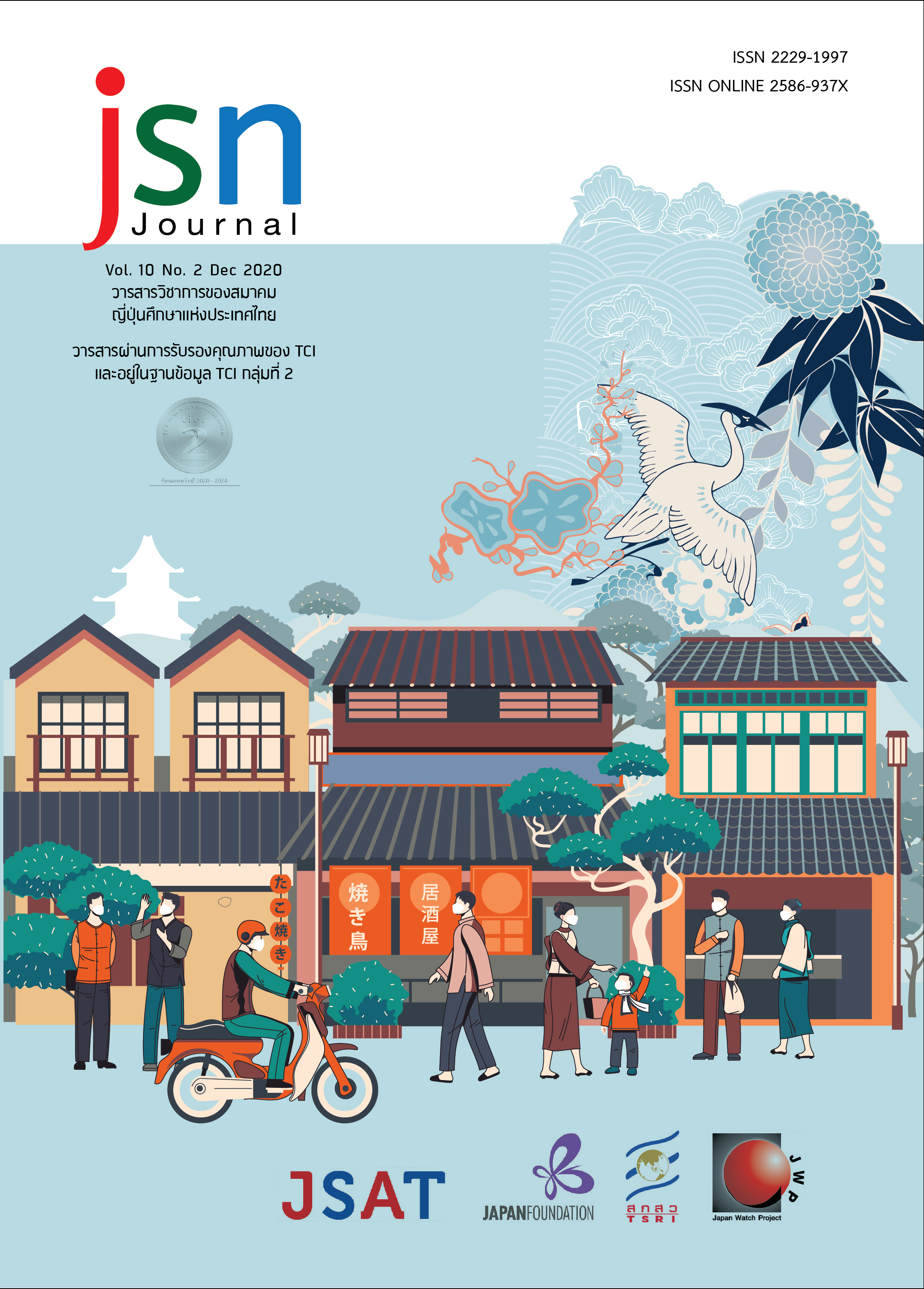Plague and Human Value in Memuchiri Kouchi
Main Article Content
Abstract
Sickness and disease have long been presented in literature. In addition to academic documents and other historical evidence, we can learn about illnesses, sicknesses, diseases and pandemics in the past through literature. The storytelling of diseases through literature not only provides readers with the opportunity to imagine the state of society at the time of the disease, it also reflects the author's view on other social issues that existed at the time. As well as the Japanese contemporary novel , Memuchiri Kouchi 『芽 む し り 仔 撃 ち 』 that was created by Oe Kenzaburo in 1958 , the author used "plague" (疫病 ) with a cholera-like symptoms as a key element of the novel in presenting various problems in Japanese society after World War II. In this article, the researcher aims to study how “plague” is used as a key element in the novel and how “plague” as a key element of the story reflects the problems of Japanese postwar society. Also, how it reflects the concept of human beings in contemporary society at that time. From the study, it was found that the author used the key element "plague" in creating the process of depriving human value of the characters and convey the concept of human values such as social inequality, the problem of oppression of power in Japanese society during that time which is a negative reflection of human beings. But at the same time, "plague" is a key element of the story in presenting positive human values, such as human independence, human friendship which reinforces the concept of the duality (両義性) of things that Oe Kenzaburo adheres
Article Details
ข้อความและข้อคิดเห็นต่างๆ ในบทความเป็นของผู้เขียนบทความนั้นๆ ไม่ใช่ความเห็นของกองบรรณาธิการหรือของวารสาร jsn Journal
References
เดือนเต็ม กฤษดาธานนท์. (2547). คำนำในฆ่ามันซะ อย่าให้มันโต. สำนักพิมพ์นานมีบุ๊คส์.
เดือนเต็ม กฤษดาธานนท์. (2549). พัฒนาการการสร้างตัวละครหญิงในวรรณกรรมของโอเอะ เคนสะบุโร.วิทยานิพนธ์ดุษฎีบัณฑิต สาขาวิชาวรรณคดีและวรรณคดีเปรียบเทียบ จุฬาลงกรณ์มหาวิทยาลัย. จุฬาลงกรณ์มหาวิทยาลัย.
นรีนุช ดำรงชัย. (2562). ญี่ปุ่นยุคร่วมสมัย: การเปลี่ยนแปลงทางสังคม การเมือง เศรษฐกิจและวัฒนธรรม. สำนักพิมพ์สถาบันบัณฑิตพัฒนบริหารศาสตร์.
โรล็องด์ บาร์ตส์. (2547). มายาคติ. แปลโดยวรรณพิมล อังคศิริ. โครงการจัดพิมพ์คบไฟ.
สุนันทา วรรณศิลป์ เบล. (2020). โรคระบาดในวรรณกรรม (Nooks and Vulture) สืบค้นจาก https://www.the101.world/epidemics-in-literature/
สุรเดช โชติอุดมพันธ์. (2556). “El amoren los tiempos de cólera: เมื่อความรักคือโรคาในลาตินอเมริกา”ใน กาเบรียล การ์เซีย มาร์เกซ. (2556). รักเมื่อคราวห่าลง. แปลโดย รัชยา เรืองศรี. สำนักพิมพ์บทจร .
โอเอะ เค็นสะบุโร. (2547). ฆ่ามันซะ อย่าให้มันโต. แปลโดย เดือนเต็ม กฤษดาธานนท์. สำนักพิมพ์นานมีบุ๊คส์.
Burns, S. (2004). “Making Illness into Identity: Writing “Leprosy Literature” in Modern Japan”In Japan Review No.16, International Research Centre for Japanese Studies, National Institutefor the Humanities, 191-211.
Centeno, M. (2011). “Discovering Minorities in Japan: First Korean Representations in Japanese Cinema.” In The Asian Conference on Cultural Studies 2011. ACCS2011. Osaka. 126-137. Retrieved from https://www.researchgate.net/publication/322919052_Discovering_Minorities_in_Japan_First_Korean_Representations_in_Japanese_Cinema/link/5a760c2645851541ce58863f/download
Johnston, W. (2020). The Modern Epidemic-A History of Tuberculosis in Japan. E-book (brill.com)
Napier, S. J. (1996). Escape from the Wasteland: Romanticism and Realism. In the Fiction of Mishima Yukio and Oe Kenzaburo (Harvard-Yenching Institute Monograph Series). Harvard University Asia Center.
Ryang, S. (2014) . “Space and Time: The Experience of the "Zainichi", The Ethnic Korean Population of Japan.” In Urban Anthropology and Studies of Cultural Systems and World Economic Development Vol. 43, No. 4, Special Issue: Emigration and Immigration: The Case of South Korea (WINTER 2014), 519-550. Retrieved from https://www.jstor.org/stable/24643204?seq=1#metadata_info_tab_contents
Spender, S. (1948). “Looking at Albert Camus’s “The Plague” in the New York Times (1 August 1948) Retrieved from https://www.nytimes.com/2020/05/15/books/review/looking-at-albert-camuss-the-plague.html
คิมยองยุน 金冷垠 (2006).あいまいな」存在としての在日像:大江健三郎の叫び声』を中心に神戸都市研究』(創刊号), 71-83.Retrieved from http://wwwlib.kobe-u.ac.jp/repository/80030008.pdf
ทะกะโอะ อิชิโจ孝夫一条 (1997).『大江健三郎―その文学の世界と背景』 和泉書院 .
ทะนิโมะริ มะซะฮิโระ และ คิมซุนอิล谷守正寛、金善日(2002) .「朝鮮人」という呼称をめぐって」鳥取大学 教育地域科学部紀要教育・人文科学』3 (2),113-133.Retrieved from file:///C:/Users/Admin/Downloads/ tujfersesh3(2)_ 113(1)%20(4).pdf
อะเบะ อิชิ 阿部一(2002).「現代日本文学にみられるアニミズム的自然観の位相空間モデル」『東洋学園大学紀要』東洋学園大学 Retrieved from https://dl.ndl.go.jp/info:ndljp/pid/8214891
อิวะตะ เอะอิซะกุ 岩田英作(1989).「『芽むしり仔撃ち』論:僕の修正をめざして」『近代文学試論27号』広島大学近代文学研究会,42-52.
อิเกะดะ อิซะโอะ 池田功 (2002).「日本近代文学と結核-負の青春文学の系譜」『明治大学人文科学研究所紀要 第五十一冊』明治大学, 1-24.
โอเอะ เค็นสะบุโร 大江健三郎(1958).「後記」『死者の奢り』文芸春秋.
โอเอะ เค็นสะบุโร 大江健三郎(1962).『世界の若者たち』新潮社.[22] โอเอะ เค็นสะบุโร 大江健三郎(1997).『芽むしり仔撃ち』新潮文庫


